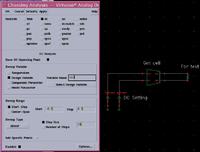M.B.
Member level 2
Hello to all,
Now I design this circuit: CMOS transconductor using varing Bias Triode Transistors for a GM-C filter.
I want to know how to simulate the transconductance of this circuit using CADENCE? (or how to know the value of the transconductance gm of a circuit by simulation?)
Also, i want to know what are the important specifications of this circuit?
Thanks to all.
Now I design this circuit: CMOS transconductor using varing Bias Triode Transistors for a GM-C filter.
I want to know how to simulate the transconductance of this circuit using CADENCE? (or how to know the value of the transconductance gm of a circuit by simulation?)
Also, i want to know what are the important specifications of this circuit?
Thanks to all.
